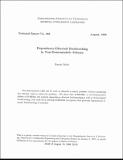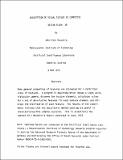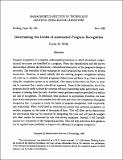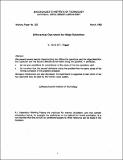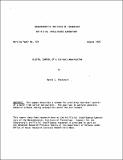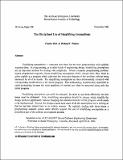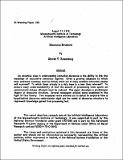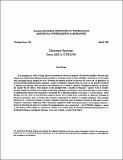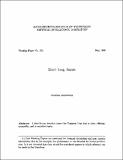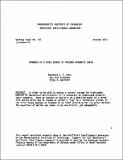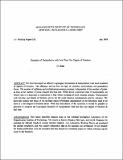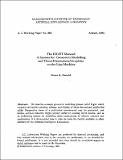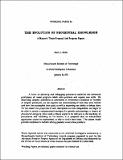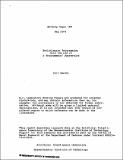Browsing AI Working Papers (1971 - 1995) by Title
Now showing items 50-69 of 291
-
DDD: Density Distribution Determination
(MIT Artificial Intelligence Laboratory, 1973-03-08)This paper presents a solution to the problem of determining the distribution of an absorbing substance inside a non-opaque non-scattering body from images or ray samplings. It simultaneously solves the problem of determining ... -
Decision Representation Language (DRL) and Its Support Environment
(MIT Artificial Intelligence Laboratory, 1989-08)In this report, I describe a language, called Decision Representation Language (DRL), for representing the qualitative aspects of decision making processes such as the alternatives being evaluated, goals to satisfy, and ... -
Dependency-Directed Backtracking in Non-Deterministic Scheme
(MIT Artificial Intelligence Laboratory, 1988-08)Non-deterministic LISP can be used to describe a search problem without specifying the method used to solve the problem. We show that SCHEMER, a non-deterministic dialect of SCHEME, can support dependency-directed backtracking ... -
Description of Visual Texture by Computers
(MIT Artificial Intelligence Laboratory, 1973-03-09)Some general properties of textures are discussed for a restricted class of textures. A program is described which inputs a scene using vidisector camera, discerns the texture elements, calculates values for a set of ... -
Design of Cooperative Networks
(MIT Artificial Intelligence Laboratory, 1983-07)In this paper we analyse several approaches to the design of Cooperative Algorithms for solving a general problem: That of computing the values of some property over a spatial domain, when these values are constrained (but ... -
Determining the Limits of Automated Program Recognition
(MIT Artificial Intelligence Laboratory, 1989-06)Program recognition is a program understanding technique in which stereotypic computational structures are identified in a program. From this identification and the known relationships between the structures, a hierarchical ... -
Differential Operators for Edge Detection
(MIT Artificial Intelligence Laboratory, 1983-03)We present several results characterizing two differential operators used for edge detection: the Laplacian and the second directional derivative along the gradient. In particular, (a)we give conditions for coincidence of ... -
Digital Control of a Six-Axis Manipulator
(MIT Artificial Intelligence Laboratory, 1976-08)This paper describes a scheme for providing low-level control of a multi-link serial manipulator. The goal was to achieve adaptive behavior without making assumptions about the environment. -
The Disciplined Use of Simplifying Assumptions
(MIT Artificial Intelligence Laboratory, 1981-12)Simplifying assumptions — everyone uses them but no one's programming tool explicitly supports them. In programming, as in other kinds of engineering design, simplifying assumptions are an important method for dealing with ... -
Discourse Structure
(MIT Artificial Intelligence Laboratory, 1976-08-17)An essential step in understanding connected discourse is the ability to link the meanings of successive sentences together. Given a growing database to which new sentence meanings must be linked, which out of many possible ... -
Discovery Systems: From AM to CYRANO
(MIT Artificial Intelligence Laboratory, 1987-03)The emergence in 1976 of Doug Lenat's mathematical discovery program AM [Len76] [Len82a] was met with suprise and controversy; AM's performance seemed to bring the dream of super-intelligent machines to our doorstep, with ... -
Does Vision Need a Special-purpose Language?
(MIT Artificial Intelligence Laboratory, 1973-09)This paper briefly discusses the following questions: What are the benefits of special-purpose languages? When is a field ready for such a language? Are any parts of our current vision research ready? -
Don't Loop, Iterate
(MIT Artificial Intelligence Laboratory, 1990-05)I describe an iteration macro for Common Lisp that is clear, efficient, extensible, and in excellent taste. -
Dynamics of a Three Degree of Freedom Kinematic Chain
(MIT Artificial Intelligence Laboratory, 1977-10)In order to be able to design a control system for high-speed control of mechanical manipulators, it is necessary to understand properly their dynamics. Here we present an analysis of a detailed model of a three-link device ... -
Dynamics of Manipulators with Less Than One Degree of Freedom
(MIT Artificial Intelligence Laboratory, 1983-01)We have developed an efficient Lagrangian formulation of manipulators with small numbers of degrees of freedom. The efficiency derives from the lack of velocities, accelerations, and generalized forces. The number of ... -
The EIGHT Manual: A System for Geometric Modelling and Three-Dimensional Graphics on the Lisp Machine
(MIT Artificial Intelligence Laboratory, 1984-08)We describe a simple geometric modelling system called Eight which supports interactive creation, editing, and display of three-dimensional polyhedral solids. Perspective views of a polyhedral environment may be generated, ... -
An Empirical Study of Program Modification Histories
(MIT Artificial Intelligence Laboratory, 1983-03)Large programs undergo many changes before they run in a satisfactory manner. For many large programs, modification histories are kept which record every change that is made to the program. By studying these records, ... -
The Evolution of Procedural Knowledge
(MIT Artificial Intelligence Laboratory, 1975-01-16)A focus on planning and debugging procedures underlies the enhanced proficiency of recent programs which solve problems and acquire new skills. By describing complex procedures as constituents of evolutionary sequences of ... -
The Evolution of Society
(MIT Artificial Intelligence Laboratory, 1991-08-05)We re-examine the evolutionary stability of the tit-for-tat (tft) strategy in the context of the iterated prisoner's dilemma, as introduced by Axelrod and Hamilton. This environment involves a mixture of populations of ... -
Evolutionary Programming with the Aid of A Programmers' Apprentice
(MIT Artificial Intelligence Laboratory, 1979-05)


